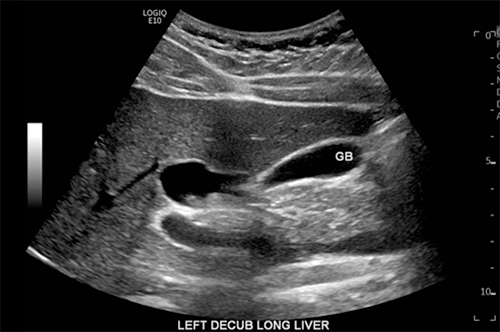Discussion
Choledochal cysts are rare clinical findings that present in many ways and at nearly all ages into adulthood.1,2 Due to increased long-term sequelae and malignancy rates, surgical excision is recommended when possible.1,5 The etiology of choledochal cysts is uncertain; several theories exist, including failed regression of the biliary tree during embryogenesis and chronic inflammation from various pathologies.2,3,6 There are five distinguished types of choledochal cysts based on the Todani classification.2‒4 Of these choledochal cysts, type II (typically presenting as an extrahepatic diverticulum) is the rarest, accounting for 2 to 3% of all choledochal cysts.4,7
Treatment for type II choledochal cysts is surgical excision, when feasible, as their presence is associated with increased rates of biliary malignancy.1,2 Due to their most common location in the extrahepatic biliary tree and the common presence of a single biliary tree connection, laparoscopic approaches are typically feasible.33 Type II choledochal cysts do not always present in childhood. This type of cysts may also be encountered during other procedures and should be resected in these scenarios when feasible.4
There have been several case reports that describe atypical presentations of type II choledochal cysts. Type II choledochal cysts have also been implicated in pancreatic disease. One report describes a young patient with hemorrhagic pancreatitis who was found to have a mixed type I and type II choledochal cyst that was resected safely,8 while another report described a patient with neoplastic degeneration of type II choledochal cyst in the pancreatic head requiring pancreaticoduodenectomy.7
Despite increasing literature and case studies regarding choledochal cysts, clinical understanding of the disease process remains limited. Additionally, choledochal cysts, particularly type II choledochal cysts, are rare clinical findings in practice. Bhojwani et al. reported a type II choledochal cyst that originated off the right hepatic duct; the cyst was thought to be a duplicate gallbladder and was safely resected laparoscopically.5 Management of our patient's intrahepatic cyst was based on several intraoperative factors and findings. Key to the decisions was the intimate anatomic relationship between the right hepatic duct and the right portal vein; avoiding injuring these structures was paramount, thus precluding the performance of a complete resection or mucosectomy. While a central hepatectomy would have removed the entirety of the cyst, the surgeons felt this option to be too extreme and highly morbid for this patient.
An intrahepatic type II choledochal cyst is a rare presentation of a rare disease process, thus making it a unique addition to the expanding literature regarding choledochal cysts and their management. With continued investigation, expanding clinician knowledge may aid in improved diagnosis and treatment of choledochal cysts. The patient in this case report had a unique presentation of an intrahepatic type II choledochal cyst originating off the right hepatic duct. He underwent partial excision, mucosectomy, fulguration, and exclusion. He was recently seen in the clinic and continues to recover uneventfully from surgery. The patient will continue to be followed clinically to monitor for continued successful recovery in the future.
Conclusion
Choledochal cysts are rare clinical findings, and type II choledochal cysts are the rarest form. We present a case of an intrahepatic type II choledochal cyst originating off of the right hepatic duct that was successfully managed laparoscopically. This study is important because it is a unique presentation of a rare disease process that can be used to increase clinical understanding and awareness of choledochal cysts.
Lessons Learned
Choledochal cysts, while rare, can present in a variety of ways. Clinicians should continue increasing awareness of different types of choledochal cysts to provide the most appropriate patient care.
References
- Soares KC, Goldstein SD, Ghaseb MA, Kamel I, Hackam DJ, Pawlik TM. Pediatric choledochal cysts: diagnosis and current management. Pediatr Surg Int. 2017;33(6):637-650. doi:10.1007/s00383-017-4083-6
- Moslim MA, Takahashi H, Seifarth FG, Walsh RM, Morris-Stiff G. Choledochal Cyst Disease in a Western Center: A 30-Year Experience. J Gastrointest Surg. 2016;20(8):1453-1463. doi:10.1007/s11605-016-3181-4
- Liu DC, Rodriguez JA, Meric F, Geiger JL. Laparoscopic excision of a rare type II choledochal cyst: case report and review of the literature. J Pediatr Surg. 2000;35(7):1117-1119. doi:10.1053/jpsu.2000.7840
- Yamashita H, Otani T, Shioiri T, et al. Smallest Todani's type II choledochal cyst. Dig Liver Dis. 2003;35(7):498-502. doi:10.1016/s1590-8658(03)00224-x
- Bhojwani R, Jain N, Mishra S. Laparoscopic evaluation and resection of type-II choledochal cyst arising from right hepatic duct mimicking gall bladder duplication [published online ahead of print, 2018 Sep 3]. J Minim Access Surg. 2018;15(2):158-160. doi:10.4103/jmas.JMAS_101_18
- Lobeck IN, Dupree P, Falcone RA Jr, et al. The presentation and management of choledochocele (type III choledochal cyst): A 40-year systematic review of the literature. J Pediatr Surg. 2017;52(4):644-649. doi:10.1016/j.jpedsurg.2016.10.008
- Jiménez-Ballester MA, Soria-Aledo V, Martín-Lorenzo JG, et al. Type II intrapancreatic choledochal malignant cyst in adults: duodenopancreatectomy. Rev Esp Enferm Dig. 2014;106(3):223-226.
- Sen SS, Menon P, Solanki S, Bhatia A, Sen IM. Acute pancreatitis with Cullen's sign presentation in a case of mixed type I and II choledochal cyst. J Pediatr Surg. 2019;54(10):2187-2190. doi:10.1016/j.jpedsurg.2019.06.011
Authors
Mahoney RCa; Woo RKa,b; Puapong DPa,b; Johnson SMa,b
Author Affiliations
- Department of Surgery, University of Hawai'i John A. Burns School of Medicine, Honolulu, HI 96813
- Department of Pediatric Surgery, Kapi'olani Medical Center for Women and Children, Honolulu, HI 96826
Corresponding Author
Reid C. Mahoney, MD
1356 Lusitana Street, Ste. 610
Honolulu, HI 96813
Phone: 630-346-6216
Email: rmahoney@hawaii.edu
Disclosure Statement
The authors have no conflicts of interest to disclose.
Funding/Support
The authors have no relevant financial relationships or in-kind support to disclose.
Received: July 18, 2020
Revision received: October 30, 2020
Accepted: November 24, 2020




